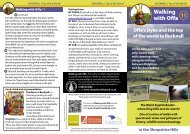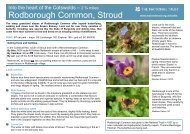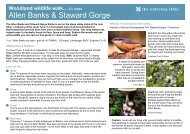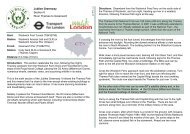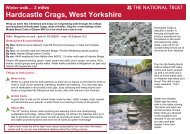Bin Combe - Butterfly Walk - Walk4Life
Bin Combe - Butterfly Walk - Walk4Life
Bin Combe - Butterfly Walk - Walk4Life
Create successful ePaper yourself
Turn your PDF publications into a flip-book with our unique Google optimized e-Paper software.
Extreme butterflying! 1½ miles<strong>Bin</strong> <strong>Combe</strong>, Exmoorwww.nationaltrust.org.uk/walksThis one is tough, very tough. The habitat is tall, dense bracken on steepslopes where there are no paths, but this is by far the best place to go inpursuit of the rare heath fritillary butterfly. Welcome to the world of extremebutterflying near Dunkery Beacon in the north of the Exmoor National Park!Start: Dunkery Beacon car park – OS Landranger 181, Explorer 9 – grid ref: SS905410Look out for…tttGetting there and facilities…By foot: 2½ mile uphill walk, NW from Wheddon Cross, on hilly countryside pathsBy bus: 398 Tiverton to Minehead service, alight at Wheddon CrossBy car: turn off the B3224 at the Blagdon Cross junction, take the minor roadacross Dunkery Hill towards Luccombe and park near the summit of the road.WC at Wheddon Cross, tea rooms in Horner village.Heath fritillaryThis rare orange and brown butterfly flies here from late May to early July. The besttime to see it is mid June. It is also most visible in sunny, warm weather. They flythroughout the combe though tend to be scarcer in the upper reaches. There arefew other butterflies, but you may see a green hairstreak, small heath, or theoccasional small pearl-bordered fritillary along the stream.Dunkery BeaconOnce you’ve had your butterfly fix at <strong>Bin</strong> <strong>Combe</strong>, explore the surrounding moorland,much of which is cared for by the National Trust. From Dunkery Beacon, the highestpoint on Exmoor, there are superb views across to Wales on a clear day. You mayspot birds of prey like Merlin or hobby hunting over the heather. Also, keep watch forDartford warblers and enjoy the song of skylarks whirling up above.Exmoor poniesThis hardy breed has roamed Exmoor since ancient times. Its stocky build and toughcoat enable the ponies to graze on the moors throughout the year, though they areherded annually and the foals are branded. Today there are thought to be just a fewthousand of these ponies worldwide.The heath fritillary was firstdiscovered on Exmoor in 1982.It has strongholds in thecombes, or steep valleys,radiating off Dunkery Beacon.The best is <strong>Bin</strong> <strong>Combe</strong>, but youcould also try Hanny, Aller andSweetworthy <strong>Combe</strong>s.© Matthew Oates / NTLower <strong>Bin</strong> <strong>Combe</strong>. This is thecore area for heath fritillary atthis site. As livestock grazinghas declined, we keepbracken growth in check byburning it off in February. Thisencourages plants like cowwheat(a parasitic plant onbilberry), upon which thebutterflies breed.During the Second World War,these moors became a militarytraining ground. Few Exmoorponies survived this. Localslater came to the rescue andhelped re-establish the breed.© Nick Meers / NTPLIn partnership with the <strong>Butterfly</strong> Conservation Society, the National Trusthas done a massive amount of work to conserve the heath fritillary onExmoor. The secret is in robust bracken management.
Route and directions…1. From the car park, head left along Dunkery Hilllane. Go past the vehicle barrier, near a twistedmoorland hawthorn bush and cross rough heatheron your left to reach the little valley of <strong>Bin</strong> <strong>Combe</strong>.Terrain and safety…1½ mile circular route. Challenging walking conditions not always on paths, some moderate to steepslopes, some loose scree surfaces. The area is heavily infested by ticks, so take precautions, likewearing long trousers tucked into socks and carefully checking yourself immediately after visit.2. Follow the east side of the stream at the top of thecombe and walk downhill. Stay on this east sidethroughout your walk. You will hopefully begin tosee heath fritillaries about 250m into the combe.Also, keep a look out for adders here.3. There is a vague path at first but once you pass arock outcrop, near the start of the woodland, thepath vanishes. Don’t worry, this is normal for <strong>Bin</strong><strong>Combe</strong>, just stick to the lower slopes and continuedownwards.Halse <strong>Combe</strong> – West Luccombe© Reproduced by permissionof Ordnance Survey.All rights reserved.OS licence no. AL 1000185914. Heath fritillaries tend to be best sighted in the lowercombe, but vary in location from year to year. Theyalso live in gorse glades. Note the yellow-lippedflowers of common cow-wheat around you. Theheath fritillary breeds on the plant, so it is essentialfor the butterfly’s survival.5. Turn left on to a clear but rough track towards thebottom of the combe, near a stream crossing.Follow this path northeast. You may see darkgreenand small pear-bordered fritillaries here.Also, check the tops of gorse bushes for littleDartford warblers.6. At a crossroad of paths, take the rough stone trackback uphill to the twisted hawthorn and the road.Keep an eye out for Exmoor ponies and red deergrazing the open moorland.On the opposite side of Dunkery Hill lane the moorlandrises up to Dunkery Beacon. It is about a ¾ mile walkfrom the car park, via a good path.CrawterHillHalse <strong>Combe</strong>WestLuccombeHornervillageHalse <strong>Combe</strong> – ½ mile – easier option…For those who prefer something a little less extreme, Heathfritillary can be found on the slopes around Flora’s Ride, the pathalong the west side of Halse <strong>Combe</strong>. Its gravel surface makes itsuitable for adventurous pushchairs and wheelchairs!As a charity, independent of government, the National Trust relies on the generosity of its supporters to continue caring for our countryside and wildlife,so that everyone can enjoy the beauty of the outdoors for generations to come.Find out more at www.nationaltrust.org.uk



